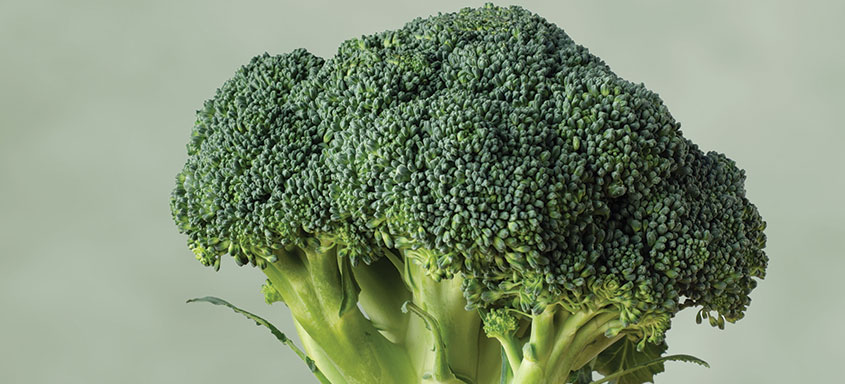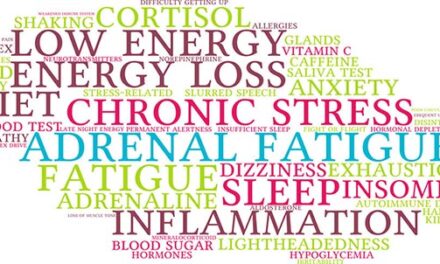Cruciferous vegetables (Brassica oleracea spp.), such as broccoli, are associated with antioxidant, cellular protection and healthy cell replication. Studies dating back several decades initially identified better health with levels of vegetable consumption and then narrowed certain types of protection more specifically to the intake of cruciferous vegetable and the total intake of glucosinolate, an important component compound. Further studies on cruciferous compounds revealed that much of the health-promoting bioactivity from these items does not arise from the compounds in their natural form as found in the vegetables and ingested with food consumption, but rather from breakdown products of glucosinolates known as isothiocyanates (ITCs). Different cruciferous vegetables provide different glucosinolates that, in turn, yield different isothiocyanates. In broccoli and broccoli sprouts the two of the most abundant glucosinolates are glucoraphanin and glucoerucin. Yet another broccoli component, myrosinase catalyzes the transformation of these glucosinolates into the isothiocyanates sulforaphane and erucin, which are their physiologically active forms. The requirement of myrosinase for the chemical transformation known as hydrolysis turns out to be a major limiting factor for the health benefits of these compounds.
Challenges to Bioavailability and Activity
Humans cannot directly transform glucosinolates into their more active forms. To a small and rather variable extent, intestinal microbes can perform this job, to be sure, yet the resulting bioactive compounds are formed below the areas in the gut with the most active uptake. This leaves plant sources of myrosinase as the limiting factor for cruciferous benefits. This is a major limitation for many reasons, including the effects of cooking, the nature of the ingested food form (the food matrix), other items ingested at the same time or shortly thereafter, and so forth and so on. For instance, cooking cruciferous vegetables inactivates myrosinase and decreases the release of isothiocyanates. Individuals who want to enhance their diets with broccoli supplements face yet more issues because these supplements most often do not contain any active myrosinase and therefore cannot produce the amount of the isothiocyanate sulforaphane that otherwise would be expected from sulforaphane glucosinolate.
Fortunately, a recent invention may have solved this problem. US Patent 9,017,666 provides a means of combining glucosinolates with myrosinase in a stable fashion for release in the small intestine. This patent, which is assigned to Jarrow Formulas of Los Angeles, provides for the creation of a dietary supplement that contains a standardized concentration of sulforaphane glucosinolate and the enzyme myrosinase water-extracted from broccoli seeds. Sulforaphane glucosinolate is metabolized to the isothiocyanate sulforaphane described above. Myrosinase facilitates this transformation when the two compounds are released together into a liquid environment. In terms of health this is important because sulforaphane has been demonstrated to be a potent inducer of Phase 2 detoxifying enzymes and to be a protector of DNA. The Phase 2 enzymes activated by sulforaphane may remain active as antioxidants in the tissues for up to three days.
A Multitude of Benefits
Looking specifically at broccoli, the primary precursor to sulforaphane commonly is known as sulforaphane glucosinolate (glucoraphanin). For at least a couple of decades, researches have been examining sulforaphane and other constituents of cruciferous vegetables as long-lasting antioxidants and much more.1–3 These compounds work together to activate the body’s Phase 1 and 2 detoxification enzymes. Phase 1 enzymes make many toxins more water-soluble in preparation for their elimination from the body, but in the process can increase the toxicity of these compounds. To counter this outcome, Phase 2 enzymes bind and remove these now soluble toxins. Thus, the Phase 1 and 2 enzyme systems must be in balance to protect health.4–6 Current research shows that sulforaphane glucosinolate initially activates Phase I enzymes. When metabolized to its isothiocyanate form as sulforaphane, the compound boosts the activities of Phase 2 enzymes and also is able to boost the level of thioredoxin, an enzyme that protects retinal cells of the eye against various types of oxidative attack.7,8 In addition, sulforaphane
- supports blood pressure and cardiovascular health9
- is active in the area of gastric health, including inhibiting Helicobacter pylori 10–12
- promotes normal healthful inflammatory responses, including the suppression of COX-2, the activation of antioxidant enzymes and modulation of cytokine production13–15
- enhances the regulation of cellular integrity16–19
- inhibits advanced glycation end product-induced damage by reducing expression of a receptor for advanced glycation end products20
Myrosinase-Activation of Sulforaphane Potential
Broccoli naturally contains myrosinase, broccoli’s own activator of sulforaphane production. However, during normal habits of consumption of broccoli and related vegetables because of cooking and other processing, generally it is left to bacterial action in the GI-tract to complete the metabolism of sulforaphane glucosinolate to sulforaphane. This is unfortunate because approximately 70 percent of sulforaphane preferentially is absorbed in the first two feet of the small intestine whereas most bacterial activation takes place below the area in the GI-tract best suited for sulforaphane absorption.21 Broccoli seed extracts, although often rich in sulforaphane glucosinolate, until now have not supplied the myrosinase needed to free sulforaphane.
Activation is only one half of the requirement for effective delivery of sulforaphane. If the two starting compounds are exposed to moisture prior to reaching the small intestine, sulforaphane glucosinolate and myrosinase will activate prematurely resulting in the loss of sulforaphane. Similarly, if sulforaphane glucosinolate and myrosinase are combined together in the acid environment of the stomach, the type of sulforaphane (sulforaphane nitrile) that is formed is largely inactive.22 This means that sulforaphane glucosinolate and myrosinase should be released only when they have reached the upper small intestine, which is the area in which sulforaphane primarily is absorbed.
The recent US Patent mentioned above solves the riddle of sulforaphane activation. It teaches how to combine sulforaphane glucosinolate and myrosinase in a stable manner and deliver them via acid resistant delayed release capsules known as DRcaps™. This facilitates the formation of sulforaphane in the upper part of the small intestine, the ideal environment for the formation and absorption of sulforaphane. BroccoMax®, the product produced by Jarrow Formulas, yields 8 mg pure sulforaphane potential per capsule. (in vitro tests)
Conclusion
Cruciferous vegetables have been shown to be sources of remarkable health-promoting substances and it long has been a goal of dietary supplements to replicate these benefits. Broccoli, as a source of sulforaphane glucosinolate that can be hydrolyzed to yield sulforaphane, is one of the most potent health promoters in the cruciferous family. However, without another key compound, myrosinase, the production of sulforaphane is small, inconsistent and dependent upon the action of intestinal bacteria. A recent US Patent has solved this issue and demonstrates a means to deliver the potential of sulforaphane glucosinolate as sulforaphane. Now a standardized amount of sulforaphane glucosinolate (glucoraphanin) can be delivered to the upper small intestine along with myrosinase, the enzyme in broccoli that metabolizes sulforaphane glucosinolate to sulforaphane. This means that the sulforaphane potential of broccoli seed extracts can be realized in the intestine at a point at which sulforaphane also is subject to its maximum uptake. At last, broccoli extracts can live up to the promise of delivering the most physiologically active compound that is derived from ingestion of broccoli, but from a supplement.
References
- Shapiro TA, et al. Chemoprotective glucosinolates and isothiocyanates of broccoli sprouts: metabolism and excretion in humans. Cancer Epidemiol Biomarkers Prev. 2001 May;10(5):501–8.
- Zhang Y. Molecular mechanism of rapid cellular accumulation of anticarcinogenic isothiocyanates. Carcinogenesis. 2001 Mar;22(3):425–31.
- Shapiro TA, Fahey JW, Wade KL, Stephenson KK, Talalay P. Human metabolism and excretion of cancer chemoprotective glucosinolates and isothiocyanates of cruciferous vegetables. Cancer Epidemiol Biomarkers Prev. 1998 Dec;7(12):1091–100.
- Myzak MC, Tong P, Dashwood WM, Dashwood RH, Ho E. Sulforaphane retards the growth of human PC-3 xenografts and inhibits HDAC activity in human subjects. Exp Biol Med (Maywood). 2007 Feb;232(2):227–34.
- Myzak MC, Dashwood WM, Orner GA, Ho E, Dashwood RH. Sulforaphane inhibits histone deacetylase in vivo and suppresses tumorigenesis in Apc-minus mice. FASEB J. 2006 Mar;20(3):506–8.
- Dashwood RH, Ho E. Dietary histone deacetylase inhibitors: from cells to mice to man. Semin Cancer Biol. 2007 Oct;17(5):363–9.
- Gao X, Talalay P. Induction of phase 2 genes by sulforaphane protects retinal pigment epithelial cells against photooxidative damage. Proc Natl Acad Sci U S A. 2004 Jul 13;101(28):10446–51.
- Tanito M, Masutani H, Kim YC, Nishikawa M, Ohira A, Yodoi J. Sulforaphane induces thioredoxin through the antioxidantresponsive element and attenuates retinal light damage in mice. Invest Ophthalmol Vis Sci. 2005 Mar;46(3):979–87.
- Wu L, Noyan Ashraf MH, Facci M, Wang R, Paterson PG, Ferrie A, Juurlink BH. Dietary approach to attenuate oxidative stress, hypertension, and inflammation in the cardiovascular system. Proc Natl Acad Sci U S A. 2004 May 4;101(18):7094–9.
- Galan MV, Kishan AA, Silverman AL. Oral broccoli sprouts for the treatment of Helicobacter pylori infection: a preliminary report. Dig Dis Sci. 2004 Aug;49(7-8):1088–90.
- Haristoy X, Angioi-Duprez K, Duprez A, Lozniewski A. Efficacy of sulforaphane in eradicating Helicobacter pylori in human gastric xenografts implanted in nude mice. Antimicrob Agents Chemother. 2003 Dec;47(12):3982–4.
- Fahey JW, Haristoy X, Dolan PM, Kensler TW, Scholtus I, Stephenson KK, Talalay P, Lozniewski A. Sulforaphane inhibits extracellular, intracellular, and antibiotic-resistant strains of Helicobacter pylori and prevents benzo[a]pyrene-induced stomach tumors. Proc Natl Acad Sci U S A. 2002 May 28;99(11):7610–5.
- Woo KJ, Kwon TK. Sulforaphane suppresses lipopolysaccharide-induced cyclooxygenase-2 (COX-2) expression through the modulation of multiple targets in COX-2 gene promoter. Int Immunopharmacol. 2007 Dec 15;7(13):1776–83.
- Zhang Y, Callaway EC. High cellular accumulation of sulphoraphane, a dietary anticarcinogen, is followed by rapid transporter-mediated export as a glutathione conjugate. Biochem J. 2002 May 15;364(Pt 1):301–7.
- Ritz SA, Wan J, Diaz-Sanchez D. Sulforaphane-stimulated phase II enzyme induction inhibits cytokine production by airway epithelial cells stimulated with diesel extract. Am J Physiol Lung Cell Mol Physiol. 2007 Jan;292(1):L33–9.
- Campbell L, Howie F, Arthur JR, Nicol F, Beckett G. Selenium and sulforaphane modify the expression of selenoenzymes in the human endothelial cell line EAhy926 and protect cells from oxidative damage. Nutrition. 2007 Feb;23(2):138–44. Epub 2006 Dec 5. Erratum in: Nutrition. 2007 Apr;23(4):378.
- Pham NA, Jacobberger JW, Schimmer AD, Cao P, Gronda M, Hedley DW. The dietary isothiocyanate sulforaphane targets pathways of apoptosis, cell cycle arrest, and oxidative stress in human pancreatic cancer cells and inhibits tumor growth in severe combined immunodeficient mice. Mol Cancer Ther. 2004 Oct;3(10):1239–48.
- Cho SD, Li G, Hu H, Jiang C, Kang KS, Lee YS, Kim SH, Lu J. Involvement of c-Jun N-terminal kinase in G2/M arrest and caspase-mediated apoptosis induced by sulforaphane in DU145 prostate cancer cells. Nutr Cancer. 2005;52(2):213–24.
- Pledgie-Tracy A, Sobolewski MD, Davidson NE. Sulforaphane induces cell type-specific apoptosis in human breast cancer cell lines. Mol Cancer Ther. 2007 Mar;6(3):1013–21.
- Maeda S, Matsui T, Ojima A, Takeuchi M, Yamagishi S. Sulforaphane inhibits advanced glycation end product-induced pericyte damage by reducing expression of receptor for advanced glycation end products. Nutr Res. 2014 Sep;34(9):807–13.
- Sulforaphane Glucosinolate Monograph, Alt Med Review 2010.
- Matusheski NV, Jeffery EH. Comparison of the bioactivity of two glucoraphanin hydrolysis products found in broccoli, sulforaphane and sulforaphane nitrile. J Agric Food Chem. 2001 Dec;49(12):5743–9.











